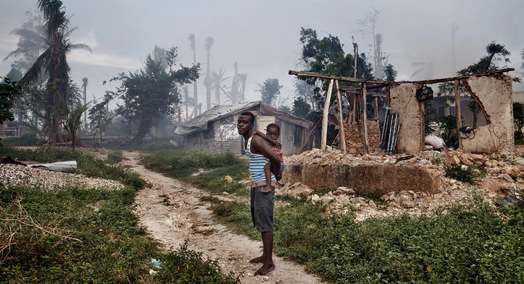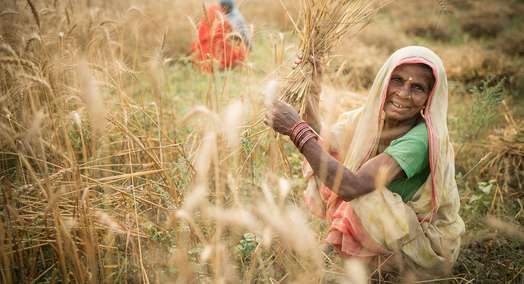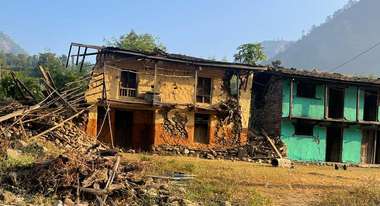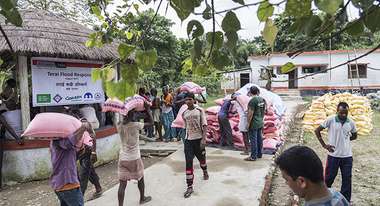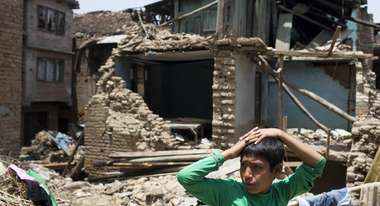"What will happen to us now?"
After the devastating earthquake that struck Nepal on 25th April 2015, Nepali families worry about their future as they have not only lost their houses but are in danger of losing their livelihoods. Three villagers share their stories.
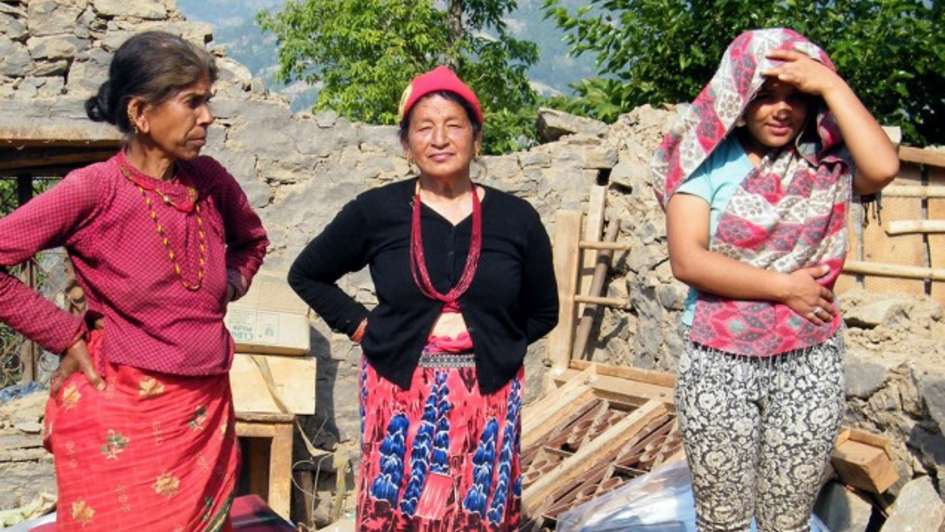
They were all inside their house. They all made it out in time, which is more than what can be said for many others. What used to be their home, is now just a heap of bricks, one single wall standing, sometimes not even that. Madhav, Suntali and Danbhadur live in different villages in the Sindhupalchowk district, one of the most severely hit by the earthquake that struck Nepal on 25 April 2015.
Death toll, numbers of injured people and damaged houses are rising
While the initial epicentre was in Gorkha district, the highest magnitude aftershock (7.1) took place in Dholakha district, east of Kathmandu. As of May 18, the death toll is 8,604 – with 16,808 people injured – and the number of destroyed houses is more than 480,000. Due to remoteness and accessibility both in terms of roads and telecommunications, many villages have still not yet been reached, making it almost a certainty that these figures will keep rising.
On that Saturday, Madhav Pandey, who lives in a village in the Thampalchhap area, had just come back home, after having attended a puja (a Hindu ritual), in the nearby village. “My wife and I had sat down to eat, and all of a sudden the house started shaking. At the beginning we weren’t sure if it was an earthquake, but when the tremor grew stronger, we immediately ran out,” recalls Madhav. Few seconds later, the house completely collapsed; the only thing that remained, a wall with two windows with blue shatters, to remind Madhav of what used to be.
Families started gathering in the open, some praying, some crying, some frantically searching for missing relatives. “I remember seeing this small child bleeding, it was heart-breaking. I am not able to explain to you how it felt,” adds Madhav, struggling to find words. He still remembers the earthquake that hit Nepal and Bihar (India) in 1988. “But this was so much bigger,” he recounts, “this was really scary!”
Most urgent needs are shelter, health and food security
Someone found a plastic sheet lying around, and they all crouched down underneath, to protect themselves from the rain that had just started pouring. In the first days, most families slept under a cotton tent, used normally for weddings and other ceremonies, but that did not keep the rain out. We really need shelter,” he explains “and the tarpaulins you brought will now make such a difference. Most people here don’t have a house anymore, they have nothing left.”
People in the village now feel very unsafe, he goes on explaining, and worry about their future. “It is not only about safety but also livelihood!” The earthquake created large deep cracks in the soil, and the upcoming heavy rains expected with the monsoon put the whole area at risk of landslides, endangering families as well as their harvest, the main source of income for these people. Shelter, as he points out, is the main priority, but after that health and food security must immediately be cared for, as the risk of diseases is very high.
The tragedy that hit Madhav and his family has however not changed the way he treats a guest. That evening, my colleague and I spent the night in a tent, and around three in the morning there was –again – a fairly strong aftershock. Sleeping in a tent in the open is unquestionably much safer than in my bed in the hotel in Kathmandu; but feeling the ground shake directly underneath you is a whole different experience, it makes you grasp the magnitude of the earth’s power – and feel very tiny and vulnerable as a human being. So when I poked out from my tent, in the morning, I am sure that the lack of sleep showed quite clearly on my face. “Ma’am,” shouted Madhav “come and have breakfast with us!” And there we sat, Madhav, his daughter, his granddaughter and myself, in front of a temporary fire-place that he had built, sipping aromatic black tea, and trying, for a bit, to chit-chat as if it was just a nice sunny day in the Nepali mountains, ignoring the houses ripped apart that were surrounding us…
After losing their homes, people are still shaken and scared
“My husband and I hid below a banana tree for the whole afternoon, we were so scared!” explains Suntali Adhikari, a lady from a village close-by. You can clearly see that she is still shaken from what happened, she keeps talking and gesticulating, and the Rural Reconstruction Nepal colleague who is translating is having troubles keeping up with her. While he reports to me what he just heard, she nods, seriously, as to reinforce the words that are being said, in a language she doesn’t understand. The changing expressions of my face as I listen, must have confirmed to her that the story was being told right. “We were sitting around the table and when it started shaking, we immediately got up from our chairs, very afraid.”
That Suntali is alive is a miracle too: she did not leave the house immediately, because she went to look for the necklace that she normally wore as a symbol of her marriage. The way she lovingly pats it, when remembering that moment, leaves no doubt as to what her priority had been that day, between the necklace and her life. Her house is also completely flattened; all their kitchen utensils are buried underneath, so they are relying on the generosity of other families, to be able to eat. Her husband has built a small shed and they are currently staying there, but this is only a temporary solution.
She and her husband are considering moving to Kathmandu, where their son and his wife live. But their house has also been destroyed, so she is very worried about what the future has in store for them. She is taking it a day at a time, as it is common in this region; today brought to her a tarpaulin and a blanket, and this is already an improvement from the day before.
With schools being destroyed, it is hard to create a sense of normality for the children
Danbhadur Gole lives in the Gunsa area, in a village that saw the first relief team (a German medical team) only one week after the earthquake. The road was opened the day before Welthungerhilfe arrived, the first NGO to appear there and to bring aid material. When we reached, we were shocked. There wasn’t a single house standing. The body of a 4-year old had been dug out from her collapsed house only two days before, her life being lost to the difficult roads and adverse access to the area. I do not know if Danbhadur had already included her in his count of 46 people dead in his small village.
He said that only three houses remained standing, all the others had completely been flattened, including his. He now sleeps under a small tent, with his four girls and one son. He shares Suntali’s worry about the future, “We do not have time to work now, we need to build our house as soon as possible”. When I ask him what the village needs the most, his answer first surprises me, but on second thought makes a lot of sense: Schools. All the schools have been destroyed and our children are sitting idle at home. This makes the parents very sad. Now that we received blankets and tarpaulins and do not need to worry about shelter anymore, we have to focus on building back the schools, so that our children can continue their education” he says. He then looks behind him, pointing at a building half collapsed “And the health centre” he adds “that must be rebuilt as soon as possible too.
The German medical team will understandably leave in a couple of weeks, and Danbhadur is worried how the village will manage. The people in Gunsa were so happy to see someone finally come for them and bring some shelter – after 12 days of wondering if they had been forgotten – that they thanked us officially, in a small ceremony where we were gifted with kathas, a Buddhist ceremonial scarf. But a tarpaulin and a blanket is only the most immediate support necessary.
Reestablishing their livelihoods will take time and a lot of work
Madhav, Suntali and Danbhadur’s difficulties are not over. They need to build back their houses, re-establish their livelihoods, start over with their lives. “We need your help”, they all said, in different ways, somehow confident that if we could bring them the shelter they so badly needed, we would certainly be able to support them in the weeks to come too. “We’ll do everyhing we can” I responded, while they were holding both my hands with both their hands, expressing their gratitude, respect and worry, but also hope and trust.
One year from now, I want to go back to Thampalchhap and to Gunsa. I want to take in the beautiful landscape that characterizes this area, the terraced soil, the golden wheat fields, the shiny green grass – this time not violated by heaps of debris and unrecognizable buildings. I want to visit Madhav, Suntali and Danbhadur, I want to be invited for tea inside their house, sitting on a chair around a table, listening to them talking about their work in the field and about their children and grandchildren. They put their faith in us, and it’s now up to us, not to disappoint them.
